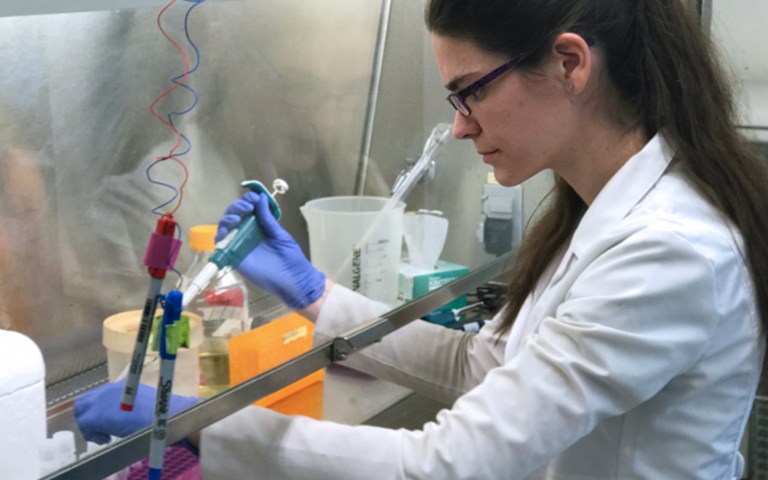Dr. Vikram Yadav and his team of researchers at UBC are bio-engineering a strain of E. coli to oxidize naphthenic acids in oil sands process waters. Courtesy of Metabolik Technologies
Process affected water is somewhat of a sticky thorn in the side of oil sands miners. Oil sands process-affected water (OSPW) generated from mining bitumen in Canada’s oil sands contains suspended and dissolved solids, salts and organic pollutants. “Essentially, it is a very gunky, gooey mixture of sand, oil, ice and problematic organics,” said Vikram Yadav, a researcher at the University of British Columbia. And while much of this water is recycled, it eventually needs to be treated and released back into the environment.
According to Yadav, one oil sands miner estimates it will generate between 50 million and 100 million cubic metres of OSPW between now and 2045.
For most of these compounds, separation and purification processes have been developed to reduce their concentration to acceptable limits. The problem area, however, are organic pollutants known as naphthenic acids (NAs).
As it stands, there is no scalable, cost-effective solution to remove NAs. As a result, once the other pollutants have been eliminated, the remaining OSPW contains a concentration in the range of 25-50 milligrams per litre (mg/l) of NA, which has shown chronic and acute toxicity to local fauna.
Yadav and his research team at UBC are now working on a solution to use a bio-engineered strain of E. coli to oxidize the NAs in oil sands miners’ OSPW. They have teamed up with Metabolik Technologies – a start-up funded by Evok Innovation and founded to deliver this solution to industry – and recently received $100,000 in funding through Genome BC’s User Partnership Program to develop the microbial strain. “This project provides a very concrete application and solution to a problem in the mining sector,” said Catalina Lopez-Correa, chief science officer and vice-president of sector development at Genome BC.
This bacteria will self-destruct in 3… 2…
Alberta is a challenging environment in which to develop a passive water treatment solution as cold temperatures limit the amount of time a bacteria could passively degrade NAs. “Things are frozen for most of the year so you’re looking at about a five- to six-month window during the summer where the [bacteria] has to degrade nearly all of the NAs that are coming in,” said Yadav.
In this environment, there already exist unique strains of microbes that are able to consume NAs, using them as a source of carbon for their own cellular metabolic activities. The only problem is that the native strains degrade NAs at a slow rate. “They are able to break down NA by as much as 90 to 95 per cent but it takes about 40 to 50 days for them to do it on a small shaker flask scale,” said Yadav. And although his team tried to manipulate the metabolism of these native strains to get the degradation rate of NAs up, they were unsuccessful.
“So then we said, ‘Let’s look at the other side of the coin and study the degradation in these native strains, then use those insights to engineer a new degradation pathway into a strain such as E. coli, which is the workhorse of industrial biotechnology,’” said Yadav.
To make things trickier, E. coli is not native to OSPW and a bio-engineered solution must adhere to strict specifications due to the nature of the project. “It has to a) survive those conditions [in Alberta], b) degrade the NAs in a timely fashion, and c) once the treatment objective reaches the appropriate level, these E. coli must self-terminate,” said James Wells, director of Metabolik Technologies.
This last step is a key aspect of the project, and one of the main reasons it caught the eye of Genome BC. Yadav referred to it as bio-containment, or engineering a “kill switch.” The idea is that once the E. coli has performed its function of neutralizing the toxin, it destroys itself. “There is no chance of damaging [living organisms] in the natural environment or causing any contamination issues,” said Rahul Singh, project manager for this initiative at Genome BC.
At this point in the research, Yadav’s team has already constructed several variants of that kill switch. They are now investigating how native strains of microbes are able to survive in this particular environment. They plan to use this information to engineer E. coli strains that rely on signals unique to OSPW. “If it were to leave these environments, the signals that it would normally receive in the tailings pond are not going to be available and therefore the strain will then essentially start producing suicide genes,” said Yadav.
The solution is designed to be the penultimate step in OSPW remediation. Once the water is remediated with the engineered E. coli, it would then be released into an engineered wetland. According to Yadav, industry “has an extensive, very aggressive research program on [wetland] construction and design.” The plant material in the wetland would eliminate any lingering toxins.
Research for the project started last July and industry began providing water samples at the beginning of this year. Metabolik is targeting the end of the year to deliver a microbe that shows progress on its three main objectives of survivability, degradation and bio-containment.
The team hopes to conduct a pilot project in a small reservoir known as a “mesocosm” by 2018. Industry could pilot the technology as early as 2019 and begin implementation of the solution thereafter.
Biology in the bigger picture
Using biology for mining applications is still pretty new. Due to mining’s inherent conservatism, companies are reluctant to take biological processes and deploy them at full scale. But there are several pilot projects taking place, according to Yadav. “What we’ve seen with mining companies is they’ve been very encouraging from the perspective of supporting some of the research and development in these technologies,” he said, pointing to research being done at UBC in collaboration with Teck Resources and First Point Minerals. “There is a desire to go the biology route.”
In terms of using engineered organisms that self-destruct, however, Yadav said he was not aware of other examples.
For the moment, the research on this project is specifically focused on developing a strain of E. coli that can degenerate NA. Nevertheless, Metabolik is investigating other areas within the mining industry where this approach could be valuable. “We’re learning what you can and can’t do with this particular strain,” said Metabolik’s Wells, “and are investigating other applications for other industries.”




